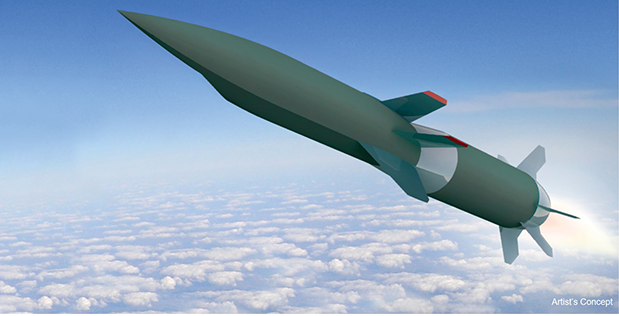An attempt by the Defense Advanced Research Projects Agency and the Air Force to fly the first Hypersonic Air-breathing Weapon Concept [HAWC] experimental missile last week failed because of testing snafus, sources report.
DARPA announced in September it had completed captive-carry testing of the two HAWC vehicle types and would be flying at least one by the end of the year. Both Lockheed Martin and Raytheon Technologies have developed HAWC demonstrators, and sources said the Lockheed vehicle was the one being tested. They said last week’s attempt can’t be re-organized by the end of December.
“This is not about a design issue,” said a source familiar with the program. “This is dumb mistakes.”
The Air Force and DARPA got telemetry aircraft up and cleared the test area, but the missile was apparently not released from its B-52 mothership. The exact nature of the problem was not disclosed, but sources implied there were “basic errors” having to do with the mechanics of the test.
The service is expected to test the AGM-183 Air-Launched Rapid Response Weapon (ARRW) by the end of the month, but that is an Air Force-only boost-glide hypersonic missile program proceeding separately from HAWC, said Air Force acquisition executive Will Roper during a Dec. 14 AFA Doolittle Leadership Center virtual forum.
A DARPA spokesman said the HAWC program is classified and the agency cannot provide any test information about it. A source familiar with the test said, “I assure you, you would have heard about it if there was something to celebrate.”
Press reports that a HAWC was inadvertently released and lost during a May captive carry flight were in error, sources said, but the missile was apparently damaged in that test, delaying additional captive carry tests for several months.
Raytheon officials said at the 2019 Paris Air Show that their HAWC might fly by the end of last year, but those predictions proved optimistic.
Hypersonic aircraft fly at speeds greater than Mach 5, or five times the speed of sound. They are challenging to defend against because of their speed and ability to maneuver unpredictably.
The Air Force and DARPA are partnered on HAWC, which seeks to test an air-breathing, scramjet-powered, hydrocarbon-fueled missile to explore engine designs, heat-resistant materials, and other technologies necessary to develop a mass-produced, affordable hypersonic standoff missile that is small enough to launch from fighter aircraft.
Aerojet Rocketdyne made the Lockheed HAWC’s engine, while Northrop Grumman supplied the engine for Raytheon’s. Northrop’s expertise stems from its purchase of Orbital ATK, now Northrop Grumman Innovation Systems, which worked on NASA’s X-43 hypersonic test vehicle. Northrop has said its HAWC engine is made entirely by additive, or 3-D, printing processes.
In a September press release, DARPA said HAWC flight tests would focus on engine performance and “thermal management techniques to enable prolonged hypersonic cruise,” along with affordable design and manufacturing techniques.
The Air Force Research Laboratory recently announced it had ground tested an 18-foot long scramjet engine in November. Built by Aerojet Rocketdyne, it produced 13,000 pounds of thrust, and is potentially applicable to a large future hypersonic vehicle. Lockheed Martin will acquire Aerojet by the end of 2021, Lockheed announced Dec. 20.
Lockheed CEO James D. Taiclet said on Dec. 21 his company could boost Aerojet’s hypersonic business opportunities by integrating them with Lockheed’s own efforts. Lockheed units working on known hypersonic projects include its “Skunk Works” advanced development unit; Space; Aeronautics; and Missiles and Fire Control.
In November, the Pentagon announced it will partner with Australia on the Southern Cross Integrated Flight Research Experiment, or SCIFiRE, an air-breathing hypersonic technology program meant to result in full-size prototype weapons within a few years, and a production system within five to 10 years. Sources report that SCIFiRE will derive at least in part from HAWC technologies and the Hypersonic International Flight Research Experiment (HIFiRE) program, a collaborative effort between the U.S. Air Force and Navy, and Australia’s Royal Australian Air Force and military technology agencies since 2005. The project will be run by the Air Force’s program executive officer for weapons, Brig. Gen. Heath A. Collins, for the Pentagon’s Directorate for Advanced Capabilities, under the undersecretary of defense for research and engineering.
The Air Force is pursuing several hypersonic weapon programs: the Hypersonic Attack Cruise Missile, an air-breather to be derived from HAWC technology demonstrations; the ARRW, and a third system, dubbed “Mayhem,” which could be larger than ARRW and carry multiple warheads. The Pentagon has said it is not pursuing hypersonic missiles with nuclear warheads.
The Air Force dropped out of a joint effort with the Army and Navy, called the Hypersonic Conventional Strike Weapon, or HCSW, in February, saying it was focusing on ARRW and HAWC.
Both the Pentagon’s Deputy Director of Defense Research and Engineering Mark Lewis and Roper have said they’ve been pleasantly surprised that air-breathing hypersonic missile development is further along than they expected when they took their respective jobs, compared with boost-glide systems that do not have a complex engine. Roper said in late April that “given how far scramjet technology has matured, I’d expect that we’ll be able to go pretty quickly” with such systems.
